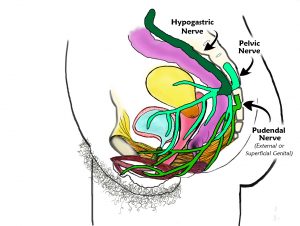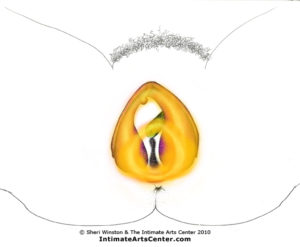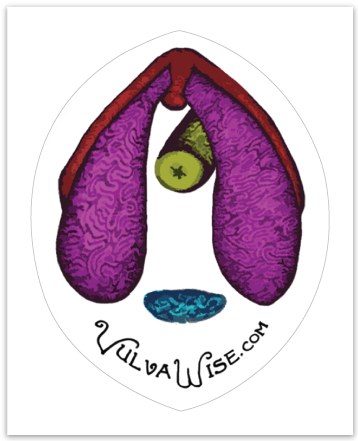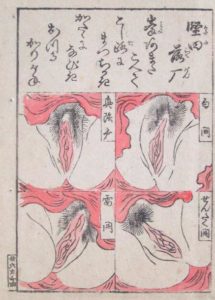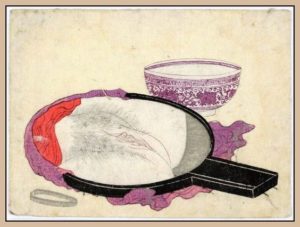 Vaginal Ecology: An Owner’s Guide to Care & Maintenance
Vaginal Ecology: An Owner’s Guide to Care & Maintenance
Part Two (Go here for Part One)
Flux and Flow
There are a variety of things that can shift the vaginal equilibrium and swing the system out of harmony.
To begin with there are the regular changes of the fertility cycle. The vaginal environment normally fluctuates slightly throughout the month for women during their fertile years. Just prior to menses, there’s a normal ebb in the population of good bacteria due to hormonal influences which causes the vagina to be less acidic. This pre-menstrual week is frequently a time when the vagina is driest, most tender and more prone to irritation and infection. During your period is another time when the environment is at risk of swinging out of balance. Blood is alkaline, (the opposite of acidic) and its presence can encourage imbalance. Semen is another alkaline influence that impacts the ecosystem. Ideally, you have a strong population of good bacteria, so your body can easily accommodate these factors and shift back to an acidic state quickly.
For post-menopausal women, the vaginal environment is most like that of the cycling woman’s pre-menstrual week. In other words, it’s somewhat dry, fragile, less acidic and has lower levels of good bacteria. It pretty much stays the same all the time although internal and external environmental factors play a role. For example, frequent arousal helps to promote blood flow and keep it more moist. Avoiding vaginal environment stressors is especially important.
Unfriendly Take-Over
If your beneficial bacteria die off then your ecosystem becomes fragile and susceptible to a take-over by unfriendly bacteria or yeast. There are many influences that can induce a decline in the population of good microbes. Sometimes imbalance just seems to happen for no reason, but factors such as high stress, poor diet, misguided ‘hygiene’ practices or other influences affecting the vaginal environment are usually at work. And when you kill off all the flowers in your garden, you can be sure that the weeds will take over.
Antibiotic Effects
One of the most common causes of a die-off of your normal flora is taking antibiotics to treat an infection. They can kill off your ‘good guys’ as they do their job of killing off the bad ones that were causing the original infection. Anytime you take antibiotics, you are at risk for yeast overgrowth, which can result in vaginal candida (a yeast infection) and gastro-intestinal problems such as indigestion and diarrhea. This is one of the many reasons to be careful about taking antibiotics and to use them only when you really need them.
Sweets for My Sweet
Normal vaginal discharge also contains a very small amount of natural sugars. The usual minimal level of sugar helps to discourage yeast overgrowth, while an increased level promotes it. The sugar level in the vaginal fluid is increased in diabetics and in pregnancy. Some women are sensitive to a high sugar diet and may find they need to be careful about their intake.
Keeping It Cool
Although the vagina is usually pretty steamy, at or slightly above normal body temperature (which is fairly toasty at almost 100°), its best if it doesn’t get much hotter then that. Anything that creates and holds in heat can contribute to an overgrowth of yeast and lead to a vaginal infection. A wet bathing suit on a hot day, pantyhose, lycra or spandex work-out clothes, synthetic panties or leggings, plastic-backed panti-liners, even tight jeans can all create an overheated crevice, at risk of disruption. Wear cotton panties, natural fiber leggings or tights, cotton menstrual pads, and nothing at all at night (or when you can get away with it!) Keep your crotch cool and you’ll be glad you did.
Contraceptive Concerns
Certain forms of contraception can affect the vaginal system, directly or indirectly. Any product that contains Nonoxynol 9, the chemical that’s in all spermicides can be problematic. Many women are highly sensitive to this chemical and will have inflammation as a result of its use. This includes condoms with spermicide, the jelly used with diaphragms and all other types of spermicidal creams, sponges and suppositories. It’s best to avoid this irritating sperm-killing chemical in all forms.
Hormonal birth control methods (birth control pills, the depo shot, implants, progesterone-containing IUDs, the ‘Patch’, the ‘Ring’), all work by tricking your body into thinking that its already pregnant and therefore doesn’t need to ovulate. So just like in actual pregnancy, there may be slightly higher amounts of natural sugars in your vaginal discharge, hormonal shifts and changes in the pH that may promote vaginal imbalance and infection.
Feminine Hygiene Crap
Exposure to synthet ic chemicals and cleansing products can also shift the balance and cause a reduction in the supportive bacteria. Vaginal infections are commonly associated with what can be called “excessive American hygiene”, which includes the use of douche, vaginal deodorants, sprays, wipes, washes, powders, anti-bacterial soaps, deodorant soaps, body washes, bubble baths, and all of those so-called feminine hygiene products. These products are one of the main culprits in vaginal infections! Avoid them all. You do not need them! Don’t fall for the mass-marketing lies that tell you that you need to be “fresh” by using their chemical concoctions. You are fresh and delicious without that synthetic junk.
ic chemicals and cleansing products can also shift the balance and cause a reduction in the supportive bacteria. Vaginal infections are commonly associated with what can be called “excessive American hygiene”, which includes the use of douche, vaginal deodorants, sprays, wipes, washes, powders, anti-bacterial soaps, deodorant soaps, body washes, bubble baths, and all of those so-called feminine hygiene products. These products are one of the main culprits in vaginal infections! Avoid them all. You do not need them! Don’t fall for the mass-marketing lies that tell you that you need to be “fresh” by using their chemical concoctions. You are fresh and delicious without that synthetic junk.
Luscious Lube
While a healthy vagina produces it’s own luscious lubrication, the amount varies from woman to woman, and for any individual, from time to time. Arousal certainly increases the amount to some extent, which may or may not be enough. In general, I’m a big fan of using extra lubrication for sex play. Slather it on! And, be aware that there are a wide variety of products, some wonderful and some not so great for your vaginal garden.
My favorite natural lubricant is organic coconut oil. It smells and tastes great, absorbs easily into skin and mucus membranes and is naturally antimicrobial against the ‘bad guys’ while promoting the health of the friendly forces. The only significant caveat is that is not compatible with latex. If you use latex barriers, do not use coconut oil!
There are a wide variety of natural, organic water-soluble lubes for those of you using latex for protection. Keep an eye out for products containing glycerin though–for some women it seems to encourage yeast infections. Silicon lubes, while not natural, do seem to work well without disturbing the vaginal ecology. Many mainstream commercial lubricants contains all sorts of very unnatural chemicals, some of which can be disruptive to the natural vaginal balance. This is a good area for you to go natural and organic!
(For more about lubricants, read Lube Rules!)
Keeping It Clean
Your healthy vagina doesn’t smell bad and doesn’t need artificial hygiene products to irritate it and kill off your normal flora. Clean with clear, clean water. That’s all you need. You can use your fingers to help rinse the crevices. A hand-held showerhead is excellent for crotch cleaning (and is also useful for self-pleasuring). A mild soap can be used on the outer areas such as the outside of the external lips but should be totally avoided on the inner lips and around the vaginal opening. There is never, ever a need to clean inside the vaginal canal at all. You have a self-cleaning vagina!
Watch for Warnings
Imbalance exists before an infection is fully manifest. By knowing what’s normal for you, you can often catch a problem early before it becomes a full-blown infection. By understanding the early signs and symptoms of a shift then you have the power to swing the ecology back into a healthy direction and prevent most problems. Or, at least catch and treat an infection early.
If there is increased or profuse discharge, if it smells wrong, tastes bad, or looks odd, that’s abnormal and usually a sign of imbalance or infection. Be alert for any changes including a funny color, if your vagina juice is thicker or thinner then usual, clumpy or milky. Your vaginal juice should never itch or burn. Swelling and irritation are also warning signs of a problem. So, be sure to check your own vaginal fluid regularly, so you’ll recognize any changes early.
Happy Healthy Haven
Now that you understand the basics of your vaginal ecology, you have the means to make good decisions to protect and care for your delicate environment. You can support your healthy system and avoid the things that might disrupt your natural defenses. By knowing what’s normal for you, and paying close attention, you can detect early signs of a problem and often fix it before it becomes a full-blown infection. When signs of imbalance occur, you can take action to correct the system yourself or get help from your health care provider, before things get really bad.
Essentially, your genitalia are a self-regulating, self-cleaning ecosystem and the less you disrupt the natural balance, the better off you’ll be. Don’t mess with a good thing. Appreciate your elegant system with its natural resilience and ability to maintain itself. Respect and support your vaginal ecology and you’ll have a happy healthy haven that feels good so you, your vagina and your friends can have lots of luscious fun!
Want more info on vaginas and related parts? I got more!

Check out my award-winning book, Women’s Anatomy of Arousal.
 You can also explore the online course by the same name, Women’s Anatomy of Arousal Online Course to learn about all things vagina!
You can also explore the online course by the same name, Women’s Anatomy of Arousal Online Course to learn about all things vagina!









